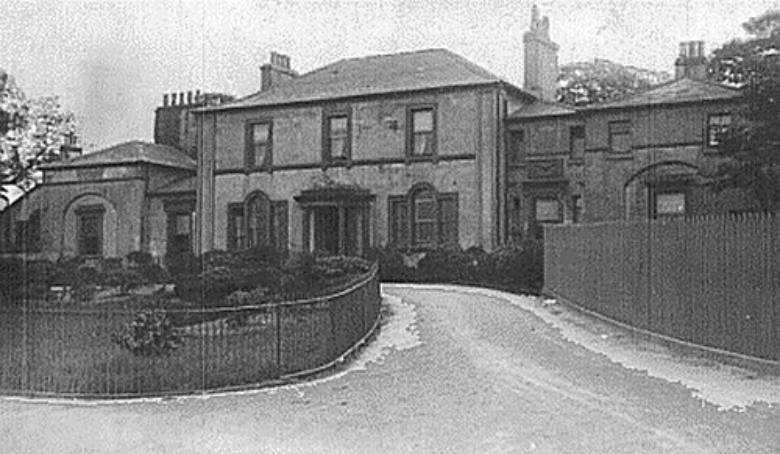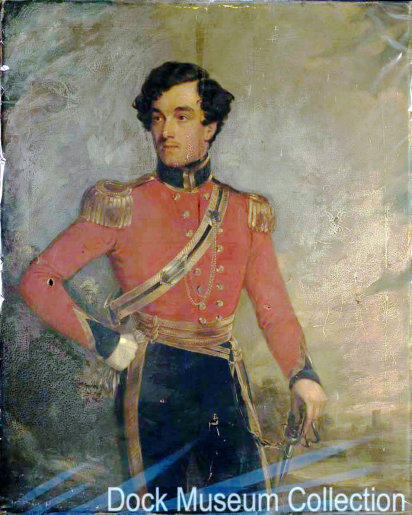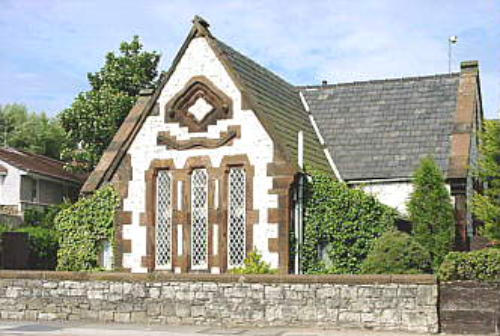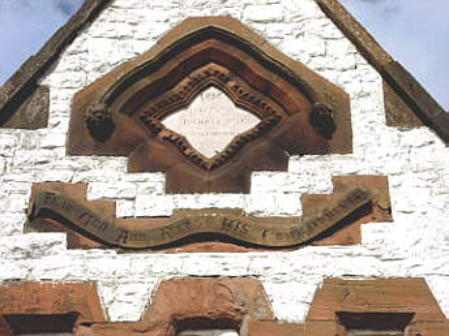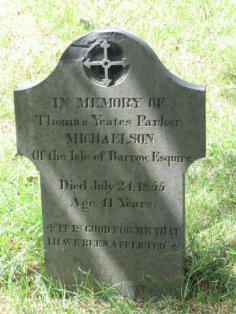The Michaelsons
THE BOYS OF OLD BARROW.
There’s a song called “The Boys of Old Barrow.” The origins of the mostly obscene lyrics are I think, lost in the mists of
time but possibly go back to World War One; or maybe further.
Very few Islanders know more than the first verse and chorus, although one elderly lady, unfortunately no longer with
us, knew all the words. Unfortunately, even for the sake of posterity she would not repeat them, “for reasons of good
taste.” Bearing the song in mind, and having nothing better to do, I set out to find the original ‘Boy of Old Barrow.’ I’m
sorry to say I failed.
The earliest Dalton Parish Register available records a certain John Jackson of Old Barrow Isle as having his son James
baptised in 1612. There follows a long line of Jacksons through the 17th century, their respective wives giving birth at
alarmingly regular intervals. Strangely, after 1702, there is no further mention of the family. Presumably, they moved - to a
bigger house - or a larger island?
NECROMANCY & AN OLD BARROW LAD.
Details of the early inhabitants of Old Barrow are hard to come by. The Dalton parish register only mentions three of
life’s significant traumas, Birth, Marriage, and Death. (Unemployment, mortgage repayments and gas bills funnily don’t get
a look in!). Also, there is no trace of an interesting character, who about 1667 was said to own the whole island. I can find
only two references to this man who inhabited the nebulous world of folklore, his name was John Wood - or was it, John
Walker?
1
&
2
Described as a necromancer and practitioner of the black arts, he was regarded by locals to be a “cunning man” who
gained respect through their primitive fear of his powers. He seemed to be the type of chap I was looking for, in my search
for a boy of Old Barrow, a species better known by its common name, an ‘Old Barrow Lad’.
There certainly were people on the island before him. Still, he had some of the slightly disreputable characteristics
that made him a splendid candidate for the accolade? An Old Barrow Lad. Which brings us to a simple farming family into
whose lives fate was to bind the future of Old Barrow inextricably.
Richard Gibson lived and finally died on Old Barrow in 1722. His son John and wife Elizabeth farmed a tenement that
occupied the site of the Kings Arms in Dalton Road. John died in 1696. About the time of John’s death, his wife was the
beneficiary in the will of a mysterious John Shaw. This man is so steeped in mystery that it takes only a little lateral
thinking to wonder whether John Shaw and John Wood/Walker were one and the same person. Now, maybe the question
is, what influence did Elizabeth’s father in law Richard, long-time Old Barrow resident have on John Wood/Walker/Shaw?
The question begs an answer because Elizabeth’s bequest was two tenements at Barrowhead and the whole of Old
Barrow Island!
In the early decades of the 18th century, a greater variety of surnames are recorded as being resident on Old Barrow.
The names Kellet, Aldron, Lowther, Seatle, Pearson, Woodend and Hoole all appear in the Baptism Section of the Dalton
Parish Register. This coincides with the arrival of a family from Greenbank, Cartmel who came to Old Barrow with a coat of
arms and a long pedigree in their luggage....
..... The Michaelsons.
1
Barrow & District, by F. Barnes refers to him as John Wood.
2
James Melville in an Evening Mail article names him John Walker.
It is carved in stone somewhere, "The Michaelsons came to Old Barrow in the early 1700s, and Robert Michaelson
acquired Old Barrow by marriage." But, by marriage to whom? Did Robert Michaelson marry the widow Gibson? It is
unlikely that a gentleman would marry a tenant's widow, having said that, the widow Gibson was now a landowner in her
own right courtesy of the nebulous John Shaw?
Funnily enough; Gibson was also the maiden name of the last private owner of Barrow Island, T.Y.P. Michaelson's wife.
Although she came from the Lancaster area, is there a connection? - Or did Robert merely buy the island from Elizabeth
Gibson?
HENRY. All this is conjecture, but the plot thickens when one refers to local historian W.B. Kendall's notes, handwritten
in an 1864 diary.[therein lies their credibility]. Kendall emphatically states that Henry Michaelson bought Old Barrow from
Mrs Elizabeth Gibson.
But contrary to most versions of the story, he dates the sale as of 17th August 1746 precisely. This date contradicts
Jane Michaelson's correspondence with local newspaper publisher Joseph Richardson in the late 1870s, where she tells of
the Michaelsons coming to Old Barrow, "in the early part of 1700."** She also states, "The present hall [Old Island Hall]
dates from about the year 1726."
JANE. If we are to take Mrs Michaelson's date of 1700 as accurate, and why should we doubt the last owner's wife?
Henry (1705-1747) would have had great difficulty buying the island, mainly because he wasn't born, although it is quite
possible he purchased it in 1746.
The Michaelson family in the 18th century were of no help to the by now, near-suicidal researcher. It is difficult to
trace a family who at that time, had a mind-boggling penchant for naming every son either Robert or Thomas. A couple of
Ezekials wouldn't have gone amiss - they stand out from the crowd. It is certain, however, that at least five generations of
the Michaelson family lived on Old Barrow until it was sold to the Furness Railway via the Duke of Devonshire in the 1860s.
The rest of this chapter hinges on Mrs Jane Michaelson's memory being sound when she wrote to Joseph Richardson.
When the Michaelsons
first came to Old Barrow,
the only buildings on the
island were a farmhouse,
near today's aptly named
Farm Street, and a cottage
set in green fields. About
1726, "in accordance with
their social standing, a fine
house was erected and was
known as Old Island Hall."
The hall stood in front of
what is now VSEL clinic in
Buccleuch Dock Road, set
back from the edge of
Barrow Channel [Buccleuch
Dock], in a vale of trees.
ROBERT. On 30th May
1730, Elizabeth Yates
presented Mr Michaelson
(as he was always
deferentially referred to),
with a son and heir whom he promptly named Robert. Then in 1733, when another son was born, they christened him
Thomas, to add to the confusion. At that time Mr Michaelson was Customs Collector at Rampside, a post held by more
than one generation of the family. Eldest son Robert (1730-1809) followed in the family footsteps holding the honourable
position of Comptroller [sic] of the King's Boat at Piel.
The Michaelson's were a wealthy and influential family in the district, in later years their involvement in local affairs
ranged from pure business to philanthropic donations to good causes.
THOMAS and ROBERT. As the Michaelsons established themselves in the area, their various business ventures
contributed in a small way to the infant Barrow's early development. To illustrate the way they were involved in local affairs
we move forward to February 1815 when Robert [yet another], Michaelson (1792-1822); son of Thomas, nephew of Robert
[argghh!], conveyed the sale to William Fisher, (another notable local) of the farm at Barrowhead once owned by Elizabeth
Gibson.
When Elizabeth died, her daughter Mary inherited the farm which she later sold to George Simpson. When George
died his son, James sold the farm to William Fisher, who in 1816 rented it out to Joseph Fisher - or did he? ....Here we go
boldly into another extremely grey area.
According to W.B. Kendall's notes, Robert Michaelson bought the farm from James Simpson in February 1815.
Michaelson then sold it to Joseph Fisher minus the orchard and some land in front of the farmhouse. On the ground, he
built a house which was sold for £211 to Principal Coast Officer, Thomas Hodgson, on 27th February 1835.
Again there is a discrepancy of opinion between two 19th century historians, but whatever the truth of the matter, the
farm was a shrewd investment. Complete with some sixty acres of land extending over what is now Mount Pleasant and
Storey Square it was a bargain at £4000.
The last owner of Old Island Hall, or as it was now more generally
known, Michaelson Mansion, was a colourful character called Thomas
Yeates Parker Michaelson.
T.Y.P. Michaelson eldest son of Robert (1792-1822), was born in
April 1814 at Old Barrow Hall. He was educated at Shrewsbury School,
a prestigious public school for gentlemen and from there went up to
Trinity College, Cambridge. On leaving university Thomas returned to
Old Barrow and took up residence at the hall. Soon after, he received a
Commission in the Furness Troop of Yeomanry Cavalry rising to the
rank of Captain. On the 2nd December 1841, he married Jane Gibson of
Quernmore Park near Lancaster, eldest daughter of the late Charles
Gibson at St Mary's Church, Lancaster. Their first son was born in July
1843 but lived only four days; the Michaelsons were eventually to have
three sons and two daughters.
BARKING MAD M'LUD. Thomas Michaelson was a complex
character; the less generous may have described him as barking mad.
By turns an amiable man willing to give visiting tradesmen the time of
day and perhaps food from his larder; generous to others whose
business caused them to visit the hall. But on a bad day, he was not a
man to be crossed.
Michaelson, although a hard taskmaster, commanded great
respect. Thomas Haslam, the tailor from Thimble Hall across on
Hindpool, would sometimes have to get up at 3 am to catch low tide so
he could safely cross Bewley Wife Steps - a ford in Barrow Channel to
reach the hall. Then, after a full day's work, he would return the same
way. This is the calibre of service Michaelson demanded and received.
At thirty Michaelson became a Justice of the Peace and was regarded as a firm but fair man. Still, he was also capable
of towering rages. His temper was so renowned locally; it made many wary of approaching the hall, especially to present a
bill for some service rendered. Michaelson could be unreasonably mean when it came to paying bills.
Joseph Fisher in his, "Popular History of Barrow in Furness," recounts how the local postman Tommy Shaw, who
earned 14 shillings [70p] a week delivering mail on foot as far as Ulverston. Tommy, after his trek over to the island was
usually treated to a feed from the kitchen and maybe a chinwag with Michaelson. At the same time Tommy was a little
afraid of his benefactor's irascibility.
One day Tommy was just leaving when two chimney sweeps appeared at the front door wanting payment for work
they'd done some time previously. Michaelson flew into one of his infamous rages shouting at them, "Hello, hello, what do
you black devils want? Be off with you!" With that, he grabbed a stick and began lashing out at the hapless sweeps.
Discretion being the better part of valour they beat a hasty retreat, Michaelson pursuing them right off the island.
The same man, however, could be most generous. When land was needed for a church and school, he donated part of
a field he owned in what is now Abbey Road. Number 251 Abbey Road now stands on his donation.
T.Y.P. Michaelson's father had added two wings to the hall, and it was now more commonly referred to as the
mansion:-
"On Old Barrow Island is a handsome mansion called Old Barrow Hall, the seat and property of T.Y.P. Michaelson Esq.,
who is also the owner of the whole island. This mansion occupies a pleasant situation near the shore, and is finely shaded
by trees."
Sadly, after being used as offices this splendid building was demolished at the beginning of World War I to make way
for the Howitzer Shop, later known as the General Machine Shop (GMS), and latterly the LED. (Light Engineering Division)
of VSEL.
the LED now lies empty, devoid of anything remotely to do with engineering, light or otherwise, a shining example of
Britain in the late 20th century.
Thomas Yeates Parker Michaelson died after a long illness on the 24th July 1855, his gravestone in St Mary's Church,
Walney Island reads.
In memory of
Thomas Yeates Parker Michaelson
of the Isle of Barrow, Esquire,
died 24th July 1855.
Aged 41 years.
"It is good for me that I have been afflicted."
Quite why it was good to be afflicted with something that caused an early death, is beyond me, but T.Y.P. managed to
inflict some problems on his wife by dying intestate. When Robert died in 1822 the property passed to his wife Millicent and
then on coming of age to T.Y.P. Michaelson, the eldest son. The problems arose when she came to sell the estate to the
Duke of Devonshire seven years later. Their eldest son and heir, Edward Brockholes Michaelson was legally still a minor. To
overcome this difficulty, an Act of Parliament was invoked, which gave his mother the right to handle Edward's affairs and
sell the estate on his behalf. In the transaction, T.Y.P. Michaelson's great-uncle Robert's will, written in 1809, was recited. It
bequeathed...
"All his separate messuages and tenements situate on the islands of Old Barrow and Old Barrow Ramsey [Island]... to
the use of Robert Michaelson the son of the said testor's nephew, Thomas Michaelson."
(Abstract of the title to Old Barrow 29.4.1863. Available for viewing by appointment at Cumbria Records Office,
Barrow).
GENEROUS TO A FAULT. The sale arrangement of the island to the Duke of Devonshire reached on the 12th April 1862
seems strange at first glance. It was agreed that the 7th Duke of Devonshire should pay Jane Michaelson,
"A sufficient sum...when invested in the stock of the Bank of England, to produce an annual income of £600."
The figure arrived at was an amazingly accurate £7,058.16s.6d. On reflection, maybe the reason for this odd
arrangement was that Jane Michaelson, now a widow, was thinking of her own future security and the children's education.
The estate sold, the family returned to Lancaster, living in High Street House.
Barrow Channel by Jayne Michaelson
On the 23rd December 1863, less than eighteen months after buying it from the widow Michaelson. The Duke of
Devonshire sold Old Barrow Island to the Furness Railway for £17,321,9s,2d, a company in which he was a major
shareholder. In the process, making himself a cool ten grand, which must equate to a £million or two at today's prices!
For an insight into the disparity of wealth in that era, [if it is needed], take the yearly rents paid by the tenants on Old
Barrow. They varied between 6/8d [33p] to a maximum of 13/4d [69p], with an additional "Greenhew Rent" of 2d [1/2p]
per annum. The Greenhew Rent allowed the tenants to cut wood from the local forests as they needed it for their personal
use. The total rent collected per annum from the tenants of Old Barrow was £4.1s.2d.
Bearing this paltry figure in mind, let us look at Robert Michaelson's tax bill for 1816.
Pounds.shillings & pence
Window Tax x 33.....................................................
£22.3s.0d.
House Duty...............................................................
£3.7s.6d.
Male Servants (5) .....................................................
£24.10s.0d.
1 x 4 wheeled carriage + 2 x 2 wheeled carriages ......
£25.0s.0d.
Riding & Race Horses ..............................................
£30.12s.6d.
Other Horses ...........................................................
£1.5s.0d.
Greyhound & five dogs ............................................
£4.10s.0d.
Armorial bearings ....................................................
£2.8s.0d.
TOTAL ..................................................................
£114.6s.0d.
The WHOLE of Hawcoat only paid £254.1s.7d.
The Michaelson family tree finally withered on the male side when Commander Charles Herbert Michaelson youngest
son of T.Y.P. Michaelson died a bachelor near Newby Bridge in 1949.
There are no monuments or statues on Barrow Island to remind us of Thomas Michaelson and his beautiful estate
which has been eradicated in the name of progress. If it weren't for the lane that ran past the lodge to his estate, now
called Michaelson Road, even his name would have been forgotten. The one lasting tribute to the man that does survive is
on Walney Island.
After his death, Jane Michaelson donated money to build a much-needed school on Walney. It was built on what is now
the Promenade in 1856, 200 yards from her husband's last resting place in St Mary's churchyard. High on the front wall
can be found the inscription.
1856
In Memory of
T.Y.P.Michaelson
of the Isle of Barrow
Underneath, a stone scroll implores us to...
"Fear God and His Commandments."
It is a neat and unusual building, once a school; it is now a private house.

